Ayon CD-10 II CD Player
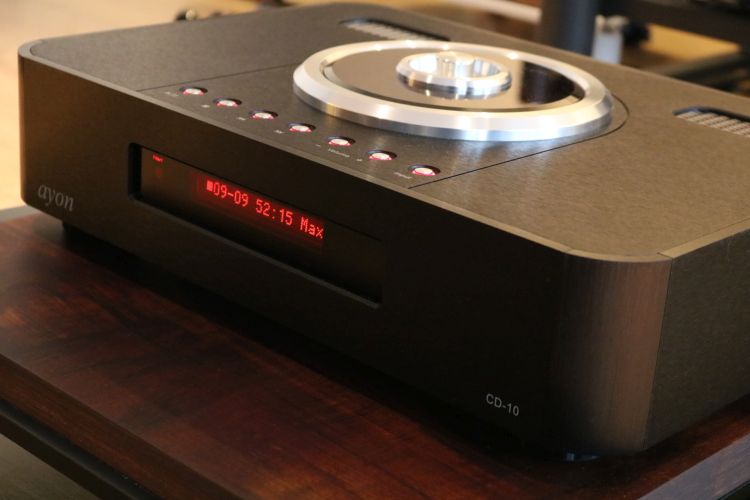
Review components supplied by Ayon
Retail Prices in the Netherlands (incl 21% VAT):
Standard version (as reviewed): 4.125 euro
Signature version upgrade: 950 euro
Ultimate version upgrade: 1.975 euro
Regular readers may have spotted it in my system on several occasions starting as early as January last year. That first exposure for the CD-10 II was the result of it having been delivered to me along with the Ayon Spirit III amplifier that was the main focus for the review. I did listen to the CD player in a limited setting and added a brief description to the amplifier review but left it at that.
Long after the CD-1o had been returned, I received a review request for the Jay’s Audio CDT-2 MkII CD transport and DAC-2 Signature and this re-acquainted me with what a good CD transport can do. Soon, I realized that there is a certain involvement aspect to a good CD player or transport that is lacking with music servers which is hard to define. It’s certainly not the rounding of transients or the overt smoothness of old and off-spec players. In fact, a good CD player or transport can sound more lively and dynamic and even more immediate than any server that I heard to date. The Ayon CD-T II Signature CD transport is the perfect example of this. When I reviewed it in 2018, I already noticed that it outperformed my music server in terms of transient sharpness and dynamic impact but by that time I was already so much invested in Roon that I did not want to go back to the CD format.
After the Jay’s review, however, I proceeded to audition several other CD transports and as a result, the Compact Disc is now once again the primary source in my main system for attentive listening sessions while the music server remains in use for casual listening, reviews and assessments.
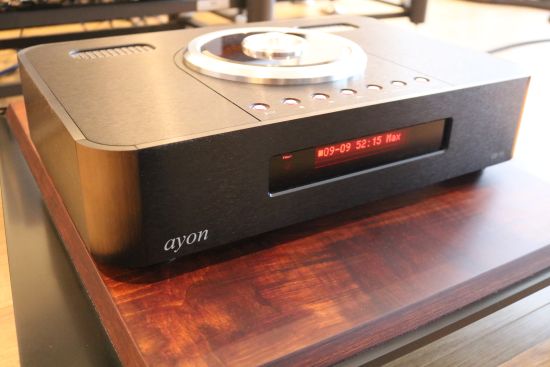
CD-10 II
Now that my affection for the CD format was fully re-sparked I remembered the CD-10 II and decided to request a review sample to give it a proper review after all. The CD-10 II is the company’s most affordable CD player and this is its latest incarnation. The MkII version incorporates a new AKM DAC design with optimized new low-pass filter technology, a revised power supply, and a new modified Sanyo CD mechanism from StreamUnlimited with a reworked new integral magnetic clamp. The CD-10 II is available in three versions: CD-10 II “Standard”, CD-10 II „Signature“ and CD-10 II “Ultimate”. This review covers the Standard version.
For a quality brand such as Ayon, “most affordable” does not mean cheap but the CD-10 II does actually offer an excellent price/performance ratio. For starters, it has many of the features as the higher-end Ayon models and the exact same build quality. Further, it’s not just a CD player. It is a DAC, digital preamp, and CD transport in a single housing. Ayon did not slap on just any DAC, either. The CD-10 II has a Class-A triode vacuum-tube output stage for single-ended & balanced operation and it outputs to both cinch and XLR. These outputs can be selected individually or, if desired, simultaneously, using a switch on the rear. All outputs can be used at the same time but as Ayon mentions in the manual, the best sound is obtained by using one set at a time.
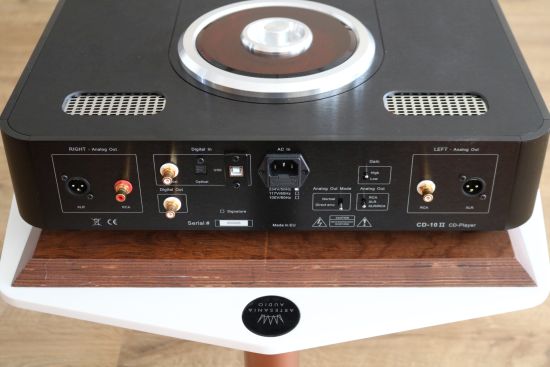
The coaxial, optical and (DSD 64x/128x-compatible-) USB inputs make it possible to use the CD-10 II as the control center of a minimalistic but very high-quality digital-only system.
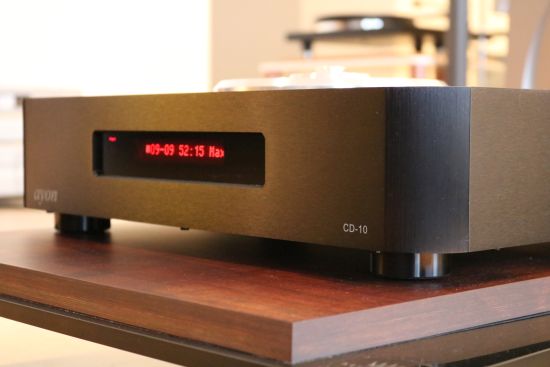
The CD-10 II can be switched between line-out mode (normal) and amplifier-direct mode. The latter should be selected when the unit is connected directly to a power amplifier. In this mode, the player always starts at -40dB after having been switched off. Also, it disables the Volume Bypass function that otherwise can be selected from the remote control. This is a safety feature that prevents heart attacks and speaker damage.
Conveniently, the player offers dedicated back-lit volume buttons on its top panel and a permanent volume indication on its front panel. With the very comprehensive IR remote control, all of its functions can be controlled, including those for Ayon amplifiers.
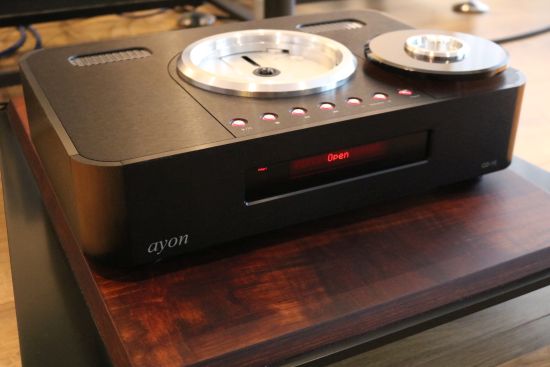
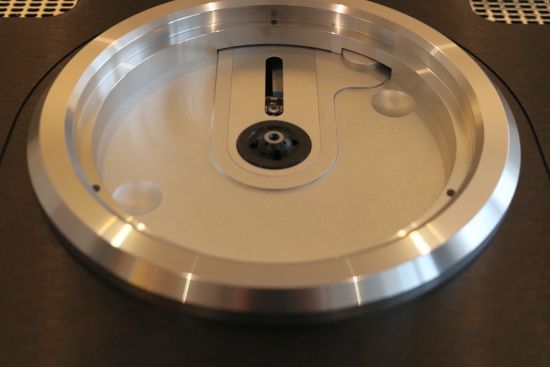
As per usual for the brand, the power switch is on the bottom of the unit, near the left side of the front panel. There are two more switches on the bottom that are labeled DMP which, I assume is short for “damping”. From the factory, they are set to ON but when I tried the OFF setting the volume is lowered which seems counter-intuitive. For what the function is intended is not made clear. The manual mentions only the following: “Only for factory settings and DMP is set to ON” from which I deduct that “ON” is indeed the factory standard setting. However, I know from earlier experience with the Ayon S10 MkII that DMP reduces the level by 6dB and increases the damping factor, thereby reducing the audibility of tube-related noises. Because the level was in line with other sources, I left them at the factory settings.
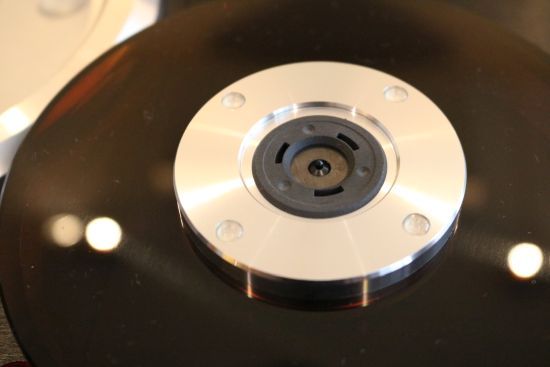
Conveniently, the puck is integrated into the lid making loading a CD a breeze
The CD-10 II offers two filter options. Filter 1 is described in the manual as a slow roll-off filter that sounds smoother and Filter 2 is described as being a fast roll-off filter that sounds more analytical. From my listening tests, I think these two descriptions are probably mixed up in the manual as Filter 1 sounds the liveliest and most open in the treble to me. In any event, I preferred Filter 1 and used this for the remainder of the review.
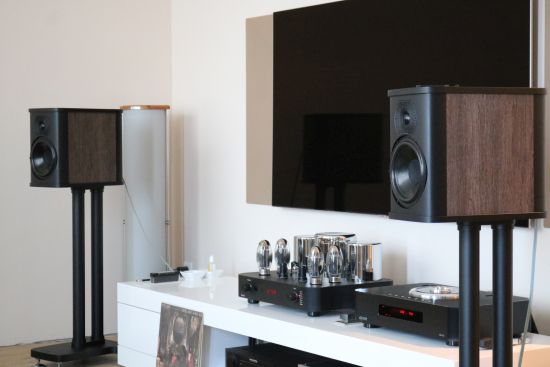
The Ayon combo sounds great in every setup that I tried it. Here, with Wilson Benesch Precision P1.0’s.
Listening
In the secondary system, I use the Ayon Spirit III KT-150 tube amplifier with an Antipodes EX music server and an ever-changing selection of turntables as sources but, so far, without a CD player. The CD-10 II sure looks great in tandem with the Ayon amp but does it also pair well? Let’s find out! Normally, this setup is flanked by Xavian Perla Esclusiva speakers and it was with these speakers that I first listened to the CD-10 II.
Powered with a Belden 19364 cable with Bals schuko and Oyaide C-004 IEC and connected to the Spirit III with an AudioQuest Water interlink, I loaded the first CD. Even fresh from its box, the CD-10 II sounds solid, upbeat, dynamic and immediately engaging!
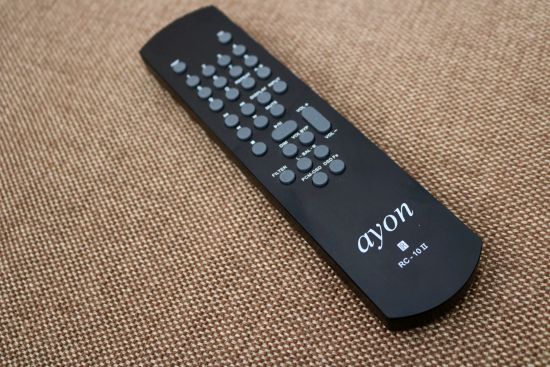
Break-in period
Rather than straying away from the subject, Ayon addresses the break-in period and describes precisely what happens during running in.
“The unit will not perform to its full sonic potential when first installed in your system. This is partially due to a residual polarization of the dielectric materials used on the printed circuit board such as resistors, capacitors, chokes, transformers and internal wiring. As music is played through the unit, the electrical signals will gradually anneal these materials”.
Ok, that’s something I can relate to. The manual goes on to describe the audible effects and notes that the break-in period should normally last 30-50 hours.
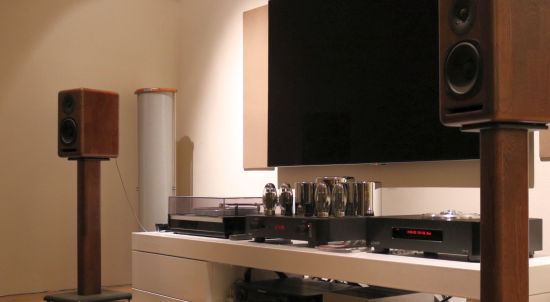
The regular setup with Xavian Perla Esclusiva’s
But instead of letting the unit just sit and play music, I jumped right in to hear it from the very first notes that it played. In line with what I have known to be the Ayon house sound, the CD-10 II has a bold, sonorous and earthy presentation. There are good openness, transparency and detail but it’s in many ways the antithesis of the typically overly clean and dry super-analytical sound and that’s precisely what I like so much about Ayon. The brand always puts the music first. It starts with the bass which is solid, upbeat, and remarkably powerful. The midrange does not have the kind of ripe lushness that some tube aficionados may expect. But that overly euphoric creaminess, in my view, is a sign of bad tube design and no Ayon component that I heard has ever shown any signs of such flaws. Rather, its midrange is rich in texture and highly credible and lifelike. With this player, wooden instruments also sound wooden and real and absolutely in no way synthetic. The treble treads a fine balance between articulate precision and airy finesse. I wouldn’t say it is the most delicate or refined treble I’ve heard but it’s certainly well-integrated, not white, not blurred and not hard but just highly credible.
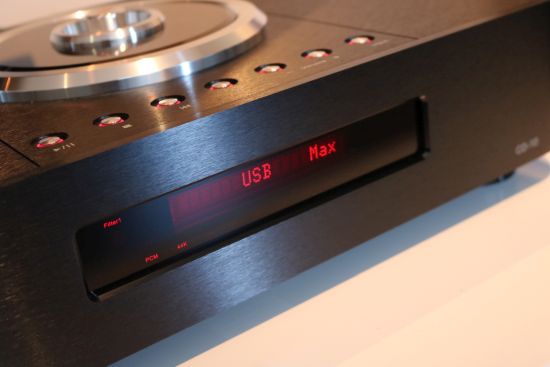
Switching to the USB input, the CD-10 II functions as a DAC with volume control, just as with the CD player. The input can conveniently be selected from the unit’s top panel or with the IR remote control.
Although I currently feel that CD’s bring something extra and this is the case with the CD-10 II as well, using a CAD USB 1 USB cable with the Antipodes EX, however, the CD-10 II still sounds great! There are the same robustness, the same convincing tonality, and very similar textures. What’s different when fed from the server, mainly, is the way that the music flows slightly less organically and the soundstage that is now a little bit more stuck to the speakers, more static, as it were. But it’s still a darn good sound!
When you want to switch back to CD, all it takes is a press of the play button and the appropriate input is automatically selected.
And all this was with pretty much no break-in. Imagine what is still in store! Well, of course, I don’t have to imagine it as I have heard how it improves over time. What happened, mostly, is that it developed a slightly more organic nature (less rigid but still very solid and authoritative) and its soundstaging flowed more freely, the more it played. I had a feeling that it stabilized already before even reaching 30 hours.
The CD-10 II also has a digital output to use it with an external DAC. While this works as it should, I wouldn’t look at this as a means to upgrade the player down the line. First, the CD-10 II is designed to be used as an integral player and as it happens in many cases, going via SPDIF to an external DAC brings advantages as well as disadvantages. The CD-10 II really is pretty hard to beat as a whole and second, as a transport, the unit is less impressive. Feeding a range of external DACs, it has a fluid, open and agile sound but it lacks much of the authority, solidity, expression, and dynamic impact that makes it such a cracking integrated player.
Also, there is a much better means of upgrading the CD-10 II that can be done right at the moment of purchase or later on. Significant steps can be taken by opting for the Signature version of the CD-10 II which includes a PCM-DSD converter for all PCM signals and very high-grade capacitors. If this works out as it did with the S-10-II Signature, then this will dot the last remaining i’s by filling in the last bit of refinement and resolution, further elevating it closer to the reference level. If you want to take it to the max you can opt for the Ultimate version which includes the PCM-DSD converter as well as a 6H30 Tube-output-stage and very high-grade coupling capacitors and other parts. This should take it all the way up to the reference level.
If the idea is to assemble a top transport-DAC combo, now or down the road, then the CD-T II should be on the top of your list. I’ve already reviewed it and it is one of the very best transports I have heard.
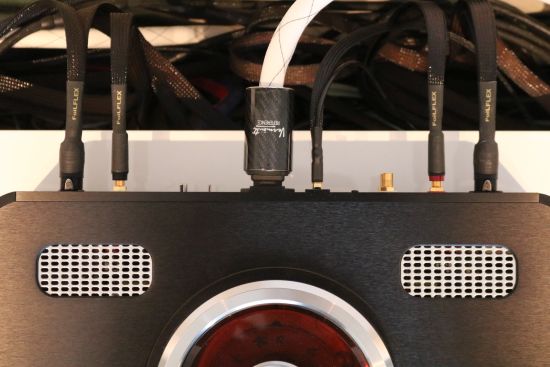
Connected with Vermouth Reference power cable and FoilFlex interlinks
Power cables
While the very neutral Belden cable works well pretty much everywhere and it clearly upgrades the standard power cord that is in the box, the CD-10 II’s inherent qualities are maximized by using the Vermouth Reference power cable. This cable has precisely the same qualities as the Ayon and joins forces to make the player sound even more solid, well-textured and authoritative.
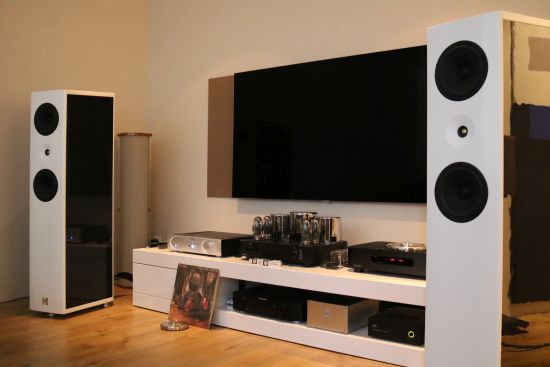
More Listening
Due to speaker experiments in the main listening room, I moved the very heavy Kroma Carmens to the secondary listening room. While I know that the Kroma’s can sound cleaner when given more space, with the exception of some unneeded room gain in the lowest frequencies, the sound is well balanced, intimate, richly textured and there is a surprisingly large soundstage that even extends beyond the front wall.
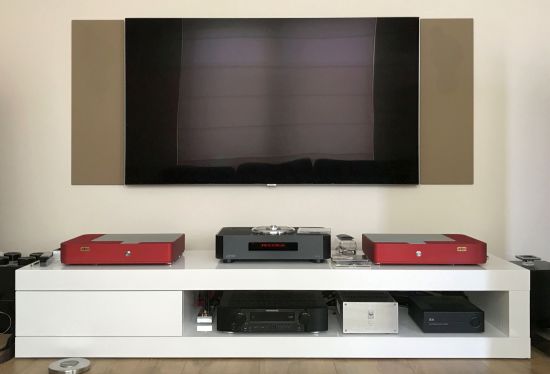
I also used the CD-10 II as the central hub in the role of a CD player and preamp in a minimalistic setup as part of the atm-audio EPM-50 review and that also worked absolutely marvelously.
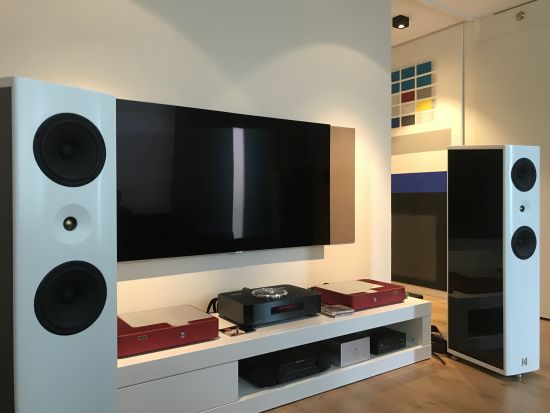
Much more so than with the Xavians and now using FoilFlex speaker cables and interlinks, the Kromas highlight how fabulously well-textured and sure-footed the CD-10 II is and how natural it sounds. I already heard it with the Xavians but the Kromas confirm that the CD-10 II not only has an organic and emotionally captivating delivery, it’s also highly dynamic and rhythmically infectious.
Listening to this system, it is hard to imagine one could desire more authority or dynamic impact. But these are actually the main areas in which dearer Ayon models distinguish themselves, usually along with even bigger soundstaging. But as it stands, I already feel that the CD-10 II offers class-leading performance in its price class. Heck, I like it so much that I made it a permanent part of my system!
Conclusion
Even in the Standard version, the CD-10 II impressed me enormously. Regular readers will know that I am used to listening to very esoteric gear but somehow Ayon always manages to stir my music-loving soul, and, as it turns out, even with their entry-level products.
Fabulously well-textured and sure-footed, organic and emotionally captivating, highly dynamic and rhythmically infectious, the CD-10 II pushes all the right buttons. It is the kind of sound that engages immediately, making one want for nothing more than just to listen to more music.

Previously a long-standing HFA favorite
Videos on the Hifi-Advice YouTube Channel
Ayon CD10 video review
HFA Front Page
External Links
Manufacturer: Ayon Audio
Distributor for the Benelux: Mafico



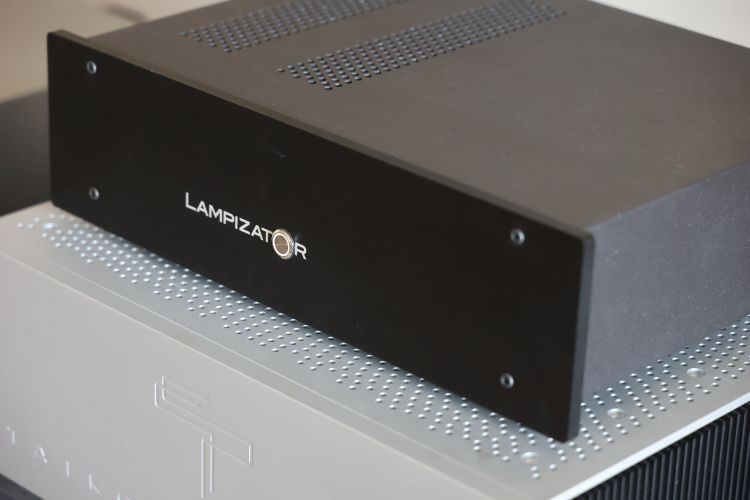
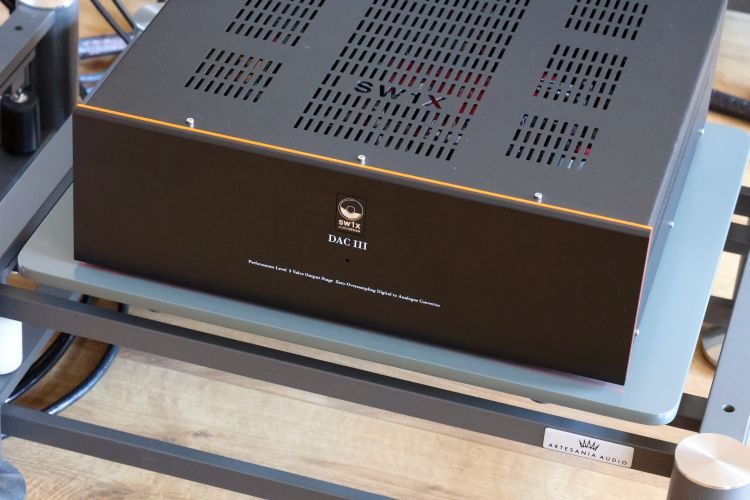
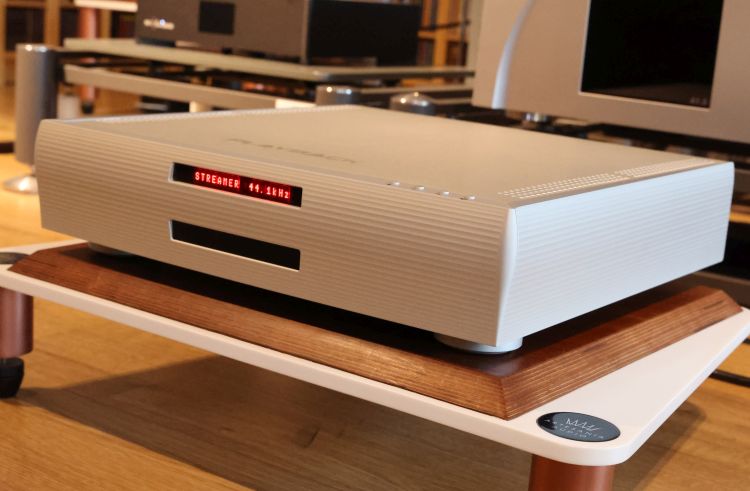
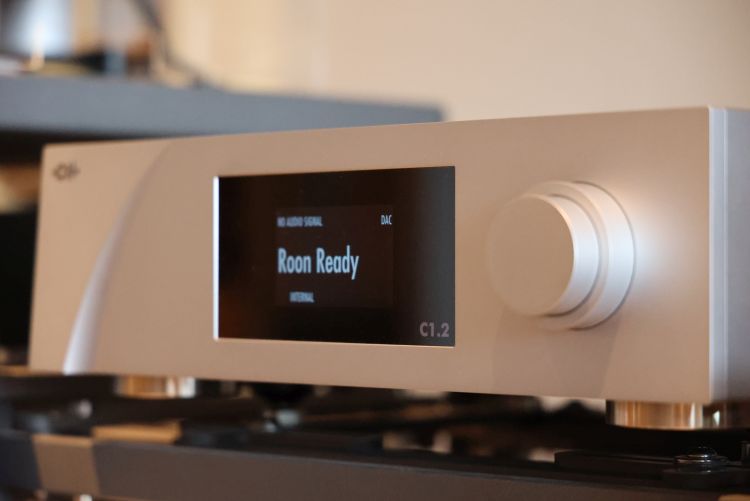
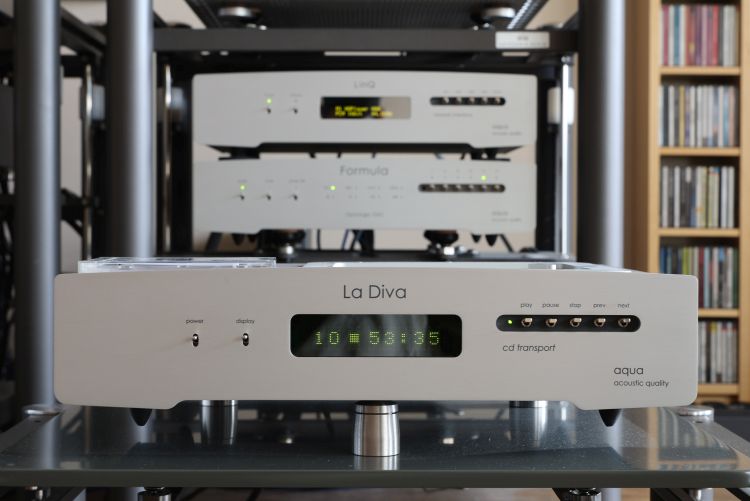
Hi Christiaan,
Thank you very much for all your work, I am always exited to read a new review on your site since I discovered it, now more than ten years ago. You reviews have always been crucial for me in this audio hobby.
My actual audio system is now:
Auralic Aries
Ayon CD 1SX (CD + DAC)
Accuphase E460
Wilson Audio Sophia I (last acquisition)
Mad Science Spdif
Audioquest Water XLR interlink
Tranparent Ultra XL speaker cables
Belden porwer cord for Auralic Aries
Transparent Powerlink MM2 for Ayon CD
Furutech alpha + Furutech Fi 28 for Accuphase
Artesania Rack
First I fully share with you that for the moment I still prefer CD sound than any streamer I have heard until now. However the streamer is very convinient…
My Ayon CD player is an older version but still I think it shares most of the sound of the actual one. When I discovered that you were using it some reviews ago, I was hoping for a specific review. Glad you made it, and now, I have some questions for you:
– The soundstaging for the CD10 II is it lower than other Ayon products you have reviewed?
– What do you think about the S-pdif digital imput? Better than the USB?
– Which gain level do you prefer: low or high?
– Have you tried other feets?
– Your prefer with or without upsampling?
Finally any advice for my audi system improvement will be apreciate.
Thank you in advance for your support,
Alex.
Thanks Alex, glad to hear it. Indeed, streaming is very convenient and personally I don’t feel forced to choose between this and other sources. I simply use all of them!
Strictly speaking, 2 horizontally-placed speakers cannot create height. Yet, I feel that I do hear differences in height from recording to recording. Soundstage height perception is something that, I think, has its basis in psychoacoustics (the way that we interpret the sound) and it also has a lot to do with the configuration of your speakers and room. My theory, a crappy one, I admit, but the only one I can think of is that darker sounding components can appear to have a soundstage less tall than brighter sounding components with multi-driver speakers that have the tweeter mounted on top. What adds some credibility to this is that I don’t hear any differences in height with the Martin Logan ESL15A’s. Of course, they are man-tall but also all the sound from the upper bass and up comes from all the parts of the foil. In the other room, I currently use the Kroma Audio Carmens and so far I’ve only compared the Ayon to the Lector combo. Between these two, the Lector was brighter and had a wider soundstage with better definition within it. However, I don’t think I perceived it as being higher. It is plausible that this also does not represent as much with d’Appolito configurations.
My servers do not have SPDIF out so I cannot compare with USB. Past experience teaches me that SPDIF can sound better than USB but it can also be the other way around. It ties in not only with the DAC’s inputs but also with the source component’s implementation. All I can say is that the CD10 II’s USB input sounds very good.
I like an expressive and solid sound and therefore I left the unit on high gain. I’ve not even tried it with this player but from past experience, I know that reducing the gain on such source components is pretty much always a matter of inserting a resistor.
I’ve not experienced with the feet. The thing is: the unit sounds great just the way it is. In my application, it does not need Ceraballs, Stillpoints or rubbery floaty devices. When an audio component sounds great without any help, I’m not tempted to try other solutions. This is not to say that other feet may not be beneficial in certain situations. But overall, I feel that Ayon products are well-balanced just the way they are.
Ah, upsampling, yes, I have tried this (and forgot to write about it) but I prefer the default setting. Upsampling does add some treble air but it also lightens the bass and gives the presentation slightly less drive and solidity.
Regarding proposed improvements, I’d encourage you to look at more upscale interlinks. While I like the Water very much and use it a lot there are better cables. But at a cost… You could try FoilFlex for a much more open and articulate sound, Vermouth for a similar balance as the Water but with more detail as well as more richness or if you can stretch it to a Final Touch Audio Ganymede or Cardas Clear, then you’ll have lots of resolution, refinement and transparency but presented in a gentle and non-edgy manner. Please read the separate reviews for all the details as all products have their pluses and minuses and cable matching remains very relative…
Ha Christiaan. Mijn zwager heeft de ML 390S en laat hem reviseren/loopwerk e.d. Daarna wil hij cd’s draaien en streamen. Ik vind jouw test erg goed van de Ayon. Er staat niet bij of hij Roon geschikt is of er alleen met een mediaplayer gestreamd kan worden. Ik vraag mij ook af of Denafrips nog beter is dan Ayon of de Naim NDX. Ik dank je vast voor je antwoord.
Hi Frans, Nice, the 390S is great as a CD player but also great as a DAC. The Ayon CD 10-II does not have an ethernet connection. If it did, I would have mentioned it and tested this functionality:-). The player does work as a DAC and can take USB, TOSlink, or S/PDIF on coax which can come from any digital source including a streamer. Denafrips and Naim are both entirely different in terms of character so that I can’t say one is better than the other. Please see the Denafrips review for more info. Same for the Ayon versus the Levinson 390S, really. The Levinson is smoother and more refined but the Ayon is more sonorous, impactful, and robust and with a more natural timbre. Besides, a DAC like the Denafrips is only as good as the signal that it is fed meaning that the streamer or CD player has a large influence on its success.
Christiaan, dank je. Ik kreeg van Mafico het bericht dat de streamerdac wel over Lan beschikt en Roon endpoint is. Zeker net aangepast. De Projectbox rs2 heeft ook een pro 8 loopwerk en lijkt veel op de Ayon Cdp.
Wij hebben bij Ben Hoedjes weleens een Metrum Hex aangesloten op de Ml390s. Klonk veel beter in direct vergelijk. Wij gaan de Denafrips Aries rechtstreeks vergelijken. Met de ml390s en ook de lux 06du.
Zelf heb ik nu de Farad 3s met Nbs dragon op Sotm10 op Asus Nas. Meer sonoor dan Aurender n10 met Totaldac usb op Rossini dac.
Groet,
Frans
Hi Frans, Since it is a network streamer, the Ayon S-10 has a LAN connection, and it is indeed Roon capable. The CD-10 II does not have an ethernet connection. The CD mechanism in the Project RS2 is not the same as the one in the CD 10-II (which is a modified Sanyo) but it uses the same CD mechanism as the new Aqua La Diva M2 which is indeed the StreamUnlimited CD Pro 8. It’s interesting making combinations trying to find the ideal one.
Thank you very much Christiaan for your answers.
Regarding the soundstage of the Ayoun CD 10II, I am sorry for my English, there is a misunderstanding. I wanted to say smaller soundstage (opposite of big) than other Ayon devices.
Regarding the interlinks I used to have Transparent Ultra MM RCA, but for my taste, it did not match well with the Ayon. I had the feeling that I was loosing the dynamic impact that the water really gives. Last question, wich of the propose interlinks (Cardas Clear, Foilflex, TA Ganymede, or Vermouth) will have similar dynamics and a bigger soundstage?
Again, thank you very much.
Alex
Hi Alex, If you want the kind of solid impact that the Water has then really only the Vermouth applies. It has similar slam and indeed a wider soundstage along with more detail.
Hi Christiaan,
excellent review as always.
You mentioned that “the Compact Disc is now once again the primary source in my main system for attentive listening sessions while the music server remains in use for casual listening, reviews and assessments.”
Can you please shed some light on which your favorite CD transport is?
Thanks
Hi Matt, I haven’t settled on any player just yet – still evaluating. So far, the ones I liked most are the Ayon CD-T II, Aqua La Diva and the Jay’s Audio CDT2 MkII. I haven’t heard the Aqua and Ayon side by side but from memory, I’d say that they are very similar and both have a tight, fast and articulate sound. The Yay’s stands out for a very different quality: its fluidity and free-flowing delivery. It’s less tight and precise and not as refined as the other two but it has a certain quality that can at times more easily induce emotion and the feeling of just wanting to relax into the music.
Hi Christiaan,
just a thought: Maybe some SQ differences between the CD transports are partly caused by the different CD clamps?
So maybe it makes sense to swap the clamps and try for example the Jays with the clamp of the Aqua?
Thank you for trying:-)
Have a nice weekend
Matt
That’s a good suggestion Matt. While it would certainly have been nice to swap Aqua and Jay’s clamps the CD-Pro2 and CDM-4 turntables are shaped very differently. Maybe the CD-Pro2 clamp would fit the Jay’s but not the other way around. In any event, the Aqua is no longer here so I can’t try.
Although I’ve heard differences in the past using various clamps on the same player, these do not account for all of the differences that I am hearing. For instance, linear mechanisms always sound different from swing-arm mechanisms, even when they are brand new, as evidenced by the Jay’s and VRDS mechanisms also have a sound of their own.
Also, from experiments that I am conducting with an engineer friend, it turns out that the type of clock, whether its frequency is native or divided, how the clock’s power supply is implemented, how the power to the servo control is done, how the player’s overall power supply and regulation are set up etc all have a huge impact on how tight and clean or how loose and warm a transport sounds. I wish it was as simple as ones are ones and zeros are zeros but every step inside the player has the potential of negatively impacting the sound and this does not only concern old and worn players. Every step is actually critical to achieving the best results. Remember that the signals are all analog and only the encoding of the signal is actually digital. These experiments are ongoing and I will eventually write a separate article about this.
Christian
Thanks for a solid review of a brand I have my eye on for sometime. I am looking for an alternative to my Esoteric K03Xs CDP. This line was one option. Right now I’ve ordered the Luxman D-06u and a Pioneer PD70ae. Could you offer any commentary on these options. Vs say the Ayon CDT-II / DAC or the top line Ultimate model?
The K03Xs is known for its transparency but harsh leading and trailing edges. And I agree with that sound profile. Lovely unit just not comfortable for pleasant listening.
Hi Matt, Indeed, I also find Esoteric players a little dry and, although impressive in certain aspects, not the most musical. Luxman D-06 is velvety smooth but arguably lacks a little drama. The Pioneer I have not heard but it looks primising. Not sure though which mechanism is used. These days, precious few are available and not all of good quality. That said, one must applaud Pioneer for issueing a product for such a niche market only a couple of years ago. I’ve never heard a Pioneer sound dry or non-musical but I also don’t think that it will sound anything like an Ayon, differing mostly, probably, in terms of timbre, texture and richness. The higher you move up on the Ayon ladder, the more sophisticated, refined and resolving it becomes but even entry-level Ayon products have the company-typical superb timbre and texture.
Hey Christian, glad I found your site. What an incredible amount of reviews. So I read your review of the Ayon CD-10 II. I am in the market for a CD player as I agree a good transport sounds better than a server. I can either get the Ayon CD-10 II or a Jays Audio CD Transport and have an additional $2500 for a new dac for the same amount of money. Your thoughts would be helpful. Thanks again.
Hi John, if you’re looking for a transport (as I did) and have a great DAC (cough-as I do;-), a CD transport such as the Jay’s is a better idea because most CD players don’t work as well as a transport. The Ayon CD10, for example, sounds lackluster when used as a transport with an external DAC. However, when used as a CD player, it sounds solid, dynamic and lively. Used as intended, it is absolutely impressive and highly musical. Oh, and it is really great as a DAC as well and it has (digital) volume control. So, if you seek a CD player or transport DAC combo, then I’d still suggest the Ayon over the Jay’s combination.
Currently I have a Chord Qutest Dac…not sure how it compare to the DAC in the Ayon but I also have a Roon Nucleus that I could run into the Ayon as a DAC for streaming. So I could play CD’s, SACD’s and Stream using the Ayon. Do you have any idea how the DAC in the Ayon compares to the Chord Qutest Dac ? Not sure if you heard that dac as it is probably on the low end of what your used to. Thanks again
Hi John, I’ve not heard the Qutest, or any Chord DACs, for that matter. For no reason at all, that just hasn’t yet materialized. So, while I can’t say much about the relative differences, I can tell you that the DACs inside the Stealth and the CD10 sound unlike any external DAC that I have heard. More likely than not, the Chord will be leaner and less colorful but perhaps a little more open and more highly resolving.
Thank you very much for the work done. you have Mark levinson components in your system. Is it worth comparing the ayon cd 10 with the Mark levinson 390s, 360s? which would you like more?
Good that you ask as I have indeed compared them, but had not published my findings. In short, the 390S and the CD-10 II are sonically very different. The Levinson excels in fluidity and refinement and it has the airiest and most velvety presentation. It also avoids sounding sterile or thin and it actually has great bass. But the Ayon counters with a more sonorous sound with considerably more robust bass and more expressive dynamic slam as well as a very natural timre with more explicit textures which is especially obvious in the midrange where it makes vocals, acoustic instruments and percussion sound more realistic. It’s quite interesting to find that of these two players, the tube one has the most robust sound as one would expect the inverse. The Ayon’s main deficit, is that it is not the most highly resolving which is especially evident in the treble which is on the dark side and could be more refined. As to which of the two I prefer… this ties in with the individual’s listening preferences, the system in which the player is used and how it is used. As a CD transport (used with an external DAC) I would choose the Levinson but as an integrated player, given my current preferences, I’d go for the Ayon.
good afternoon again. I beg your pardon. My system is not expensive. ML 380s, ML 335, Revel f208. The system had a source of Ayon cd2s and I sold it. Ayon cd2s I liked how he learns. Wanted to update my source on Ayon cd5s. Many people advise to buy ML37-ML360S for ML. How do you think cd5s will yield to ml360s in resolution?
Personally, I prefer 390S over 37+360S. In terms of resolution and finesse, the Levinsons will win. But note that many people mistake attack or dynamics for detail or finesse. I have not heard the Ayon CD5. The CD10 sounds more dynamic than the Levinsons so, if you think an explicit sound comes across as more detailed then you may prefer the Ayon. The Levinsons are airier and subtler, more like Retina or 4K versus HD. Not sharper but containing more info. It’s also a matter of perspective.
I’ve an old system consisting of watt puppy 7’s, pass labs x1 and xa30.5 and transparent ultra cabling throughout and am thinking of getting this CD player as a source. Would appreciate your thoughts given I’ve no experience with tubes at all, but am curious if it would match well. Also reason for this choice is using it as a cd based source direct into amp. Oh, and I think you may be pleasantly surprised by the effect of bypassing the preamp.
Without knowing what other sources you use or have used and what it is that you expect from a new source, I can only make a generic comment. The Ayon is a great CD player that works just as well in tube systems as it does in transistor systems. The player is a little dark but never harsh while the Wilsons can be a little piercing at times so I think that it should also work very well with the WP8’s.
Hi I thought I’d drop an update on my system today. I found an estate sale Audio Research Ref CD9 which I sent for upgrading then delivered to Saudi when the power supply failed. Back it went to the USA and then back to me again. It’s now firing on all tubes and simply the best sound I’ve ever had. When feeding my ARC LS10SE and Luxman M900u into Viking Acoustics L’Instrument horn speakers with super tweeter upgrade it’s a dream system. The bass mids and treble, the liveliness and dynamics are simply outstanding. And I learned to take the Pioneer N70ae SE signal via coaxial into the CD9 and let the CD9 do the DAC conversion. Again a massive improvement over the original sound even though this Pioneer was upgraded too. Simply wonderful energy . I wish I could post you all a sample. Nevertheless I have replaced the dry shrill of the Esoteric with this system today abd cannot imagine anything more.
Hi John, despite never having never an Audio Research CD player in my system, I did hear them at shows and in demos and I have a good feeling about them. Based on my non-controlled listening, I’d guesstimate that the ARC players sound smoother and more relaxed than the Ayon CD 10-II and in a way closer to the Levinson 390S, and potentially just as revealing and, of course, with some tube magic thrown in:-)